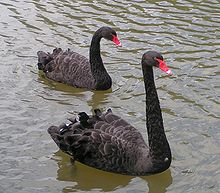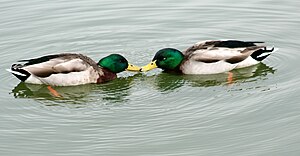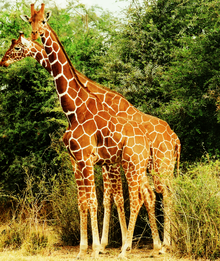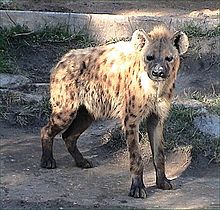Homosexual behavior in animals: Difference between revisions
No edit summary |
|||
| Line 1: | Line 1: | ||
[[Image: |
[[Image:Swanny2.jpg|thumb|The [[Bonobo]] displays the highest rate of homosexual activity in any animal, being a fully [[bisexual]] species.<ref name=penisfencing>{{cite book | author= Frans B. M. de Waal |authorlink= Frans de Waal| title=The ape and the sushi master : cultural reflections by a primatologist | year 2001 | publisher=Basic Books | chapter=Bonobos and Fig Leaves}}</ref><ref>[http://www.colszoo.org/animalareas/aforest/bonobo.html Bonobos at the Columbus Zoo]</ref>]] |
||
'''[[Homosexual]]''' (as well as [[bisexual]]) behavior is widespread in the '''[[animal kingdom]]'''. [[Non-human animal sexual behavior|Animal sexual behavior]] takes many different forms, even within the same [[species]] and the motivations for and implications of their behaviors have yet to be fully understood as most species have yet to be studied.<ref name="‘Catalogue of Life’ reaches">{{cite web |
'''[[Homosexual]]''' (as well as [[bisexual]]) behavior is widespread in the '''[[animal kingdom]]'''. [[Non-human animal sexual behavior|Animal sexual behavior]] takes many different forms, even within the same [[species]] and the motivations for and implications of their behaviors have yet to be fully understood as most species have yet to be studied.<ref name="‘Catalogue of Life’ reaches">{{cite web |
||
| last =Gordon |
| last =Gordon |
||
Revision as of 14:52, 13 February 2008
Homosexual (as well as bisexual) behavior is widespread in the animal kingdom. Animal sexual behavior takes many different forms, even within the same species and the motivations for and implications of their behaviors have yet to be fully understood as most species have yet to be studied.[3] A 1999 review by researcher Bruce Bagemihl shows that homosexual behavior, not necessarily sex, has been observed in close to 1500 species, ranging from primates to gut worms, and is well documented for 500 of them.[4][5]
Homosexuality in animals is seen as controversial because some assert it points to the naturalness of homosexuality in humans, while others counter that it has no implications and is nonsensical to use animal behavior to justify what is or is not immoral.[6][7]
| Sexual orientation |
|---|
 |
| Sexual orientations |
| Related terms |
| Research |
| Animals |
| Related topics |
Applying the term homosexual to animals
The term homosexual was coined in Prussia in the 1869 to describe same-sex sexual attraction and sexual behaviour in humans [8]. Its use in animal studies has been controversial for two main reasons: animal sexuality and motivating factors have been and remain poorly understood, and the term has strong cultural implication in western society that are irrelevant for other species than humans.[9]
Animal preference and motivation is always inferred from behaviour. Thus homosexual behaviour has been given a number of terms over the years. The correct usage of the term homosexual is that an animal exhibit homosexual behaviour, however this article conforms to the usage by modern research [10][11][12][13] applying the term homosexuality to all sexual behaviour (copulation, genital stimulation, mating games and sexual display behaviour) between animals of the same sex.
Research on homosexual behavior in animals
The presence of same-sex sexual behavior was not 'officially' observed on a large scale until recent times, possibly due to observer bias caused by social attitudes to same-sex sexual behavior. It appears to be widespread amongst social birds and mammals, particularly the sea mammals and the primates.
"No species has been found in which homosexual behaviour has not been shown to exist, with the exception of species that never have sex at all, such as sea urchins and aphis. Moreover, a part of the animal kingdom is hermaphroditic, truly bisexual. For them, homosexuality is not an issue."[14]
Some researchers believe it to have its origin in male social organization and social dominance, similar to the dominance traits shown in prison sexuality. Others, particularly Joan Roughgarden, Bruce Bagemihl, Thierry Lodé [15] and Paul Vasey suggest the social function of sex (both homosexual and heterosexual) is not necessarily connected to dominance, but serves to strengthen alliances and social ties within a flock. Others have argued that social organization theory is inadequate because it cannot account for some homosexual behaviors, for example, penguin species where same-sex individuals mate for life and refuse to pair with females when given the chance.[16] While reports on many such mating scenarios are still only anecdotal, a growing body of scientific work confirm that permanent homosexuality occur in species with permanent pair bonds, but also in non-monogamous species like sheep.
One report on sheep cited below states:
- "Approximately 8% of rams exhibit sexual preferences [that is, even when given a choice] for male partners (male-oriented rams) in contrast to most rams, which prefer female partners (female-oriented rams). We identified a cell group within the medial preoptic area/anterior hypothalamus of age-matched adult sheep that was significantly larger in adult rams than in ewes..."[17] In fact, apparent homosexual individuals are known from all of the traditional domestic species.
Cross-species sex
Although a commonly held conception is that animals' sexuality is instinctive almost to the point of being mechanistic, research regularly records that many animals are sexual opportunists, and may show an interest in other partners than their own or related species. This is more visible in domesticated species, as domestication commonly selects for increased breeding rate (and so an accelerated breeding cycle has commonly arisen in domesticated species over the centuries), and also because these species are easier to witness by humans. Nevertheless non-domesticated animals have been observed to attempt sexual activity with other species, or indeed inanimate objects. This form of cross-species sex has occasionally been observed in the wild (polecat-mink, [18]), however most observations are from animals in captivity (such as the zoo).
If the pair are a male and a female, hybrid offspring can result if the two species are related. However, this offspring may not be able to breed itself. The mule, for example (horse/donkey cross) is normally sterile, whilst the liger (lion/tiger cross) is sometimes fertile. Novosibirsk zoo director Rostislav Shilo says on the liger (born in its zoo); “It’s just that the lion and the tiger live in neighboring caves in the Novosibirsk zoo, and got used to each other. It’s practically impossible in the wild.”. Cross species sex in the wild has been observed between several species, among them blue tit and great tit, Chimpanzees and olive baboons and Amazon River Dolphin and the tucuxi dolphin.
Some selected species and groups
American Bison

Courtship, mounting, and full anal penetration between bulls has been noted to occur among American Bison. The Mandan nation Okipa festival concludes with a ceremonial enactment of this behaviour, to "ensure the return of the buffalo in the coming season."[19] Also, mounting of one female by another is common among cattle. Inter-sexual bison also occur. The Lakota refer to them as pte winkte —pte meaning bison and winkte designating two-spirit— thereby drawing an explicit parallel between transgender in animals and people.[19]
Birds


An estimated one-quarter of all black swans pairings are homosexual and they steal nests, or form temporary threesomes with females to obtain eggs, driving away the female after she lays the eggs.[20] More of their cygnets survive to adulthood than those of different-sex pairs possibly due to their superior ability to defend large portions of land.
In early February 2004 the New York Times reported a male pair of chinstrap penguins in the Central Park Zoo in New York City were partnered and even successfully hatched a female chick from an egg.[21] Other penguins in New York have also been[22] reported to be forming same-sex pairs.
Zoos in Japan and Germany have also documented gay male penguin couples.[16] The couples have been shown to build nests together and use a stone to replace an egg in the nest. Researchers at Rikkyo University in Tokyo, found 20 gay pairs at 16 major aquariums and zoos in Japan. Bremerhaven Zoo in Germany attempted to break up the gay male couples by importing female penguins from Sweden and separating the male couples, but they were unsuccessful. The zoo director stated the relationships were too strong between the gay couples.
Studies have shown that 10 to 15 percent of female western gulls in some populations in the wild are lesbian.[23]
Bonobo and other apes
The bonobo, which has a matriarchal society (unusual amongst apes), is a fully bisexual species -- both males and females engage in heterosexual and homosexual behavior, being noted for lesbianism in particular. About 60% of all sexual activity in this species is between two or more females. While the homosexual bonding system in bonobos represent the highest frequency of homosexuality known in any species, homosexuality has been reported for all great apes, including humans, as well as a number of other primate species.[1][24][25][26][27][28][29][30][31]
Bottlenose Dolphins
Bottlenose Dolphin males have been observed working in pairs or larger groups to follow and/or restrict the movement of a female for weeks at a time, waiting for her to become sexually receptive. The same pairs/groups have also been observed engaging in ardent sexual play with each other.
Janet Mann, Georgetown University professor of biology and psychology, argues that the strong personal behaviour among male dolphin calves is about bond formation and benefits the species in an evolutionary context.[23] She cites studies showing that these dolphins later in life as adults are in a sense bisexual, and the male bonds forged earlier in life work together for protection as well as locating females to reproduce with.
Dragonflies

Male homosexuality has been inferred in several species of dragonflies (the order Odonata). The cloacal pinchers of male damselflies and dragonflies inflict characteristic head damage to females during sex. A survey of 11 species of damsel and dragonflies[32][33] has revealed such mating damages in 20 to 80 % of the males too, indicating a fairly high occurrence of sexual coupling between males.
Elephants
African, as well as Asiatic males will engage in same-sex bonding and mounting. Such encounters are often associated with affectionate interactions, such as kissing, trunk intertwining, and placing trunks in each other's mouths. The encounters are analogous to heterosexual bouts, one male often extending his trunk along the other's back and pushing forward with his tusks to signify his intention to mount. Unlike heterosexual relations, which are always of a fleeting nature, those between males result in a "companionship", consisting of an older individual and one or two younger, attendant males. Same-sex relations are common and frequent in both sexes, with Asiatic elephants in captivity devoting roughly 45% of sexual encounters to same-sex activity.[34]
Fruit flies
Male Drosophila melanogaster flies bearing two copies of a mutant allele in the fruitless gene court and attempt to mate exclusively with other males.
Giraffes

Researchers have treated homosexual behavior in animals as a taboo subject perhaps from innocent confusion or even from a fear of "being ridiculed by their colleagues."[14] A case of overlooking behaviour is noted by Bruce Bagemihl describing mating giraffes where nine out of ten pairings occur between males.
"Every male that sniffed a female was reported as sex, while anal intercourse with orgasm between males was only "revolving around" dominance, competition or greetings.[14]
Japanese Macaque
With the Japanese Macaque, also known as the "snow monkey", same-sex relations are frequent, though rates vary between troops. Females will form "consortships" characterized by affectionate social and sexual activities. In some troops up to one quarter of the females will form such bonds, which will vary in duration from a few days to a few weeks. Often, strong and lasting friendships will result from such pairings. Males also have same-sex relations, typically with multiple partners of the same age. Affectionate and playful activities are associated with such relations.[35]
Lions

Both male and female lions have been seen to interact homosexually.[36][37] Male lions pair-bond for a number of days and initiate homosexual activity with affectionate nuzzling and caressing, leading to mounting and thrusting. About 8% of mountings have been observed to occur with other males, while female pairings are held to be fairly common in captivity but have not been observed in the wild.
Lizards
Whiptail lizard (Teiidae genus) females have the ability to reproduce through parthenogenesis and as such males are rare and sexual breeding non-standard. Females engage in sexual behavior to stimulate ovulation, with their behavior following their hormonal cycles; during low levels of estrogen, these (female) lizards engage in "masculine" sexual roles. Those animals with currently high estrogen levels assume "feminine" sexual roles.
Lizards that perform the courtship ritual have greater fertility than those kept in isolation due to an increase in hormones triggered by the sexual behaviors. So, even though asexual whiptail lizards populations lack males, sexual stimuli still increase reproductive success.
From an Evolutionary standpoint, these females are passing their full genetic code to all of their offspring (rather than the 50% of genes that would be passed in sexual reproduction). Certain species of gecko also reproduce by parthenogenesis.
Polecat

European polecats Mustela putorius were found to engage homosexuality in non sibling animals. Deliberate exclusive homosexuality with mounting and anal penetration in this solitary species apparently serves no adaptive function[38].
Sheep
An October 2003 study by Dr. Charles E. Roselli et al. (Oregon Health and Science University) states that homosexuality in male sheep (found in 8% of rams) is associated with a region in the rams' brains which the authors call the "ovine Sexually Dimorphic Nucleus" (oSDN) which is two times smaller than the corresponding region in heterosexual male sheep.[17]

It should be noted that some view this study to be flawed in that the determination of homosexuality within the sheep (sample population of 27 for the study) was to have animals who were unable to mount female ewes placed in a cage with two stanchioned males and two unstanchioned females (i.e. the males could not move or struggle while the females could). Given the aggressive nature of sheep copulation, the uneven treatment of males and females, many see this as simply evidence that the sheep in question were unable to be aggressive enough to mount females. As with most animal homosexuality, the results were situational sexuality, unlike the bonds seen in human homosexuality.[citation needed]
The scientists found that, "The oSDN in rams that preferred females was significantly larger and contained more neurons than in male-oriented rams and ewes. In addition, the oSDN of the female-oriented rams expressed higher levels of aromatase, a substance that converts testosterone to estradiol, a form of estrogen which is believed to facilitate typical male sexual behaviors. Aromatase expression was no different between male-oriented rams and ewes."
"The dense cluster of neurons that comprise the oSDN express cytochrome P450 aromatase. Aromatase mRNA levels in the oSDN were significantly greater in female-oriented rams than in ewes, whereas male-oriented rams exhibited intermediate levels of expression." These results suggest that "...naturally occurring variations in sexual partner preferences may be related to differences in brain anatomy and its capacity for estrogen synthesis."[17] As noted prior, given the potential unagressiveness of the male population in question, the differing aromatase levels may also have been evidence of aggression levels, not sexuality. It should also be noted that the results of this study have not been confirmed by other studies.
Spotted Hyena

The female Spotted Hyena has a unique urinary-genital system, closely resembling the penis of the male. The family structure is matriarchal and dominance relationships with strong sexual elements are routinely observed between related females.
Early naturalists thought hyenas were hermaphrodites or commonly practiced homosexuality, largely due to the female spotted hyena's unique urogenital system which looks more like a penis than a vagina.[39] According to early writings such as Ovid's Metamorphoses and the Physiologus, the hyena continually changed its sex and nature from male to female and back again. In Paedagogus, Clement of Alexandria noted that the hyena (along with the hare) was "quite obsessed with sexual intercourse." Many Europeans associated the hyena with sexual deformity, prostitution, deviant sexual behavior and even witchcraft. Research has shown that "in contrast to most other female mammals, female Crocuta are male-like in appearance, larger than males, and substantially more aggressive,"[40] they have "been masculinized without being defeminized.”[39]
This unique genitalia and aggressive behavior in the female hyena has led to the understanding that more aggressive females are better able to compete for resources including food and mating partners.[41][39] Research has shown that "elevated levels of testosterone in utero"[42] contributes to extra aggressiveness from their mother and both males and females mount members of the same sex,[43][42] who in turn are possibly acting more submissive because of lower levels of testosterone from their mothers.[40]
References
- ^ a b Frans B. M. de Waal. "Bonobos and Fig Leaves". The ape and the sushi master : cultural reflections by a primatologist. Basic Books.
{{cite book}}: Text "year 2001" ignored (help) - ^ Bonobos at the Columbus Zoo
- ^ Gordon, Dr Dennis (10 April 2007). "'Catalogue of Life' reaches one million species". National Institute of Water and Atmospheric Research. Retrieved 2007-09-10.
{{cite web}}: Check date values in:|date=(help); Cite has empty unknown parameter:|coauthors=(help) - ^ Bruce Bagemihl, Biological Exuberance: Animal Homosexuality and Natural Diversity, St. Martin's Press, 1999; ISBN 0312192398
- ^ Harrold, Max (2/16/1999). "Biological Exuberance: Animal Homosexuality and Natural Diversity". The Advocate, reprinted in Highbeam Encyclopedia. Retrieved 2007-09-10.
{{cite web}}: Check date values in:|date=(help) - ^ Solimeo, Luiz Sérgio (21 September 2004). "The Animal Homosexuality Myth". NARTH, National Association for Research & Therapy of Homosexuality. Retrieved 2007-09-10.
{{cite web}}: Check date values in:|date=(help); Cite has empty unknown parameter:|coauthors=(help) - ^ Solimeo, Luiz Sérgio (2004, ISBN 187790533X). "Defending A Higher Law: Why We Must Resist Same-Sex "Marriage" and the Homosexual Movement". Spring Grove, Penn.: The American TFP. Retrieved 2007-09-10.
{{cite web}}: Check date values in:|date=(help); Cite has empty unknown parameter:|coauthors=(help) - ^ The first known use of the word Homoseksuäl is found in Benkert Kertbeny, K.M. (1869): Paragraph 143 des Preussichen Strafgesetzebuches vom 14/4-1851 und seine Aufrechterhaltung als Paragraph 152 im Entwurf eines Strafgesetzbuches fur den Norddeutschen Bundes, Leipzig, 1869. Reprinted in Jahrbuch fur sexuelle Zwischenstufen 7 (1905), pp. 1-66
- ^ Dorit, Robert (September–October 2004). "Rethinking Sex". American Scientist. Retrieved 2007-09-11.
{{cite web}}: CS1 maint: date format (link) - ^ Bruce Bagemihl, Biological Exuberance: Animal Homosexuality and Natural Diversity, St. Martin's Press, 1999; pp.122-166
- ^ Joan Roughgarden, Evolutions rainbow: Diversity, gender and sexuality in nature and people, University of California Press, Berkeley, 2004; pp.13-183
- ^ Vasey, Paul L. (1995), Homosexual behaviour in primates: A review of evidence and theory, International Journal of Primatology 16: p 173-204
- ^ Sommer, Volker & Paul L. Vasey (2006), Homosexual Behaviour in Animals, An Evolutionary Perspective. Cambridge University Press, Cambridge. ISBN-10: 0521864461
- ^ a b c "1,500 Animal Species Practice Homosexuality". News-medical.net. 2006-10-23. Retrieved 2007-09-10.
{{cite web}}: Check date values in:|date=(help) - ^ T Lodé La guerre des sexes chez les animaux" Eds O Jacb, Paris, 2006, ISBN 2-7381-1901-8
- ^ a b "Gay Penguins Resist 'Aversion Therapy'". 365 Gay.com. February 11 2005. Retrieved 2007-09-10.
{{cite web}}: Check date values in:|date=(help) - ^ a b c Roselli, Charles E. (2004, vol. 145, no2, pp. 478-483). "The Volume of a Sexually Dimorphic Nucleus in the Ovine Medial Preoptic Area/Anterior Hypothalamus Varies with Sexual Partner Preference". Journal of Endocrinology, Endocrine Society, Bethesda, MD,. Retrieved 2007-09-10.
{{cite web}}: Check date values in:|date=(help); Unknown parameter|coauthors=ignored (|author=suggested) (help)CS1 maint: extra punctuation (link) Cite error: The named reference "The Volume of a Sexually Dimorphic" was defined multiple times with different content (see the help page). - ^ LODÉ T., GUIRAL G. & PELTIER D. 2005. European mink-polecat hybridization events: hazards from natural process ? Journal of Heredity 96 (2): 1-8
- ^ a b Bagemihl, Bruce (Spring 2000). "Left-Handed Bears & Androgynous Cassowaries: Homosexual/transgendered animals and indigenous knowledge". Whole Earth Magazine. Retrieved 2007-06-16.
- ^ Goudarzi, Sara (16 November 2006). "Gay animals out of the closet?: First-ever museum display shows 51 species exhibiting homosexuality". MSNBC. Retrieved 2007-09-12.
{{cite web}}: Check date values in:|date=(help) - ^ Smith, Dinitia (February 7 2004). "Love That Dare Not Squeak Its Name". New York Times. Retrieved 2007-09-10.
{{cite web}}: Check date values in:|date=(help); Cite has empty unknown parameter:|coauthors=(help) - ^ "They're in love. They're gay. They're penguins... And they're not alone". Columbia University, Columbia News Service. June 10 2002. Retrieved 2006-07-21.
{{cite web}}: Check date values in:|date=(help) - ^ a b Smith, Dinitia (February 7 2004). "Central Park Zoo's gay penguins ignite debate". San Francisco Chronicle, reprinted from New York Times. Retrieved 2007-09-10.
{{cite web}}: Check date values in:|date=(help); Cite has empty unknown parameter:|coauthors=(help) - ^ Bonobos at the Columbus Zoo
- ^ Dawkins, Richard (2004). "Chimpanzees". The Ancestor's Tale. Houghton Mifflin.
- ^ Frans B. M. de Waal (1995). "Bonobo Sex and Society". Scientific American. pp. 82–88. Retrieved 2006-07-17.
{{cite web}}: Unknown parameter|month=ignored (help) - ^ Frans de Waal, "Bonobo Sex and Society" in Scientific American (March 1995), p. 82ff
- ^ The behavior of a close relative challenges assumptions about male supremacy in human evolution
- ^ Courtney Laird, "Social Organization"
- ^ Stanford, C. B. (1998). The social behavior of chimpanzees and bonobos. Current Anthropology 39: 399–407.
- ^ Kano, Takayoshi (1992). The Last Ape: Pygmy Chimpanzee Behavior and Ecology. Stanford, CA: Stanford University Press.
- ^ Dunkle, S.W. (1991), Head damage from mating attempts in dragonflies (Odonata:Anisoptera). Entomological News 102, pp. 37-41
- ^ Utzeri, C. & C. Belfiore (1990): Anomalous tandems in Odonata. Fragmenta Entomologica 22(2), pp. 271-288
- ^ Bruce Bagemihl, Biological Exuberance: Animal Homosexuality and Natural Diversity, St. Martin's Press, 1999; pp.427-430
- ^ Bruce Bagemihl, Biological Exuberance: Animal Homosexuality and Natural Diversity, St. Martin's Press, 1999; pp.302-305
- ^ Bruce Bagemihl, Biological Exuberance: Animal Homosexuality and Natural Diversity, St. Martin's Press, 1999; pp.302-305. In his discussion of lion same-sex relations, Bagemihl is making use of published work by: J.B. Cooper, "An Exploratory Study on African Lions" in Comparative Psychology Monographs 17:1-48; R.L. Eaton, "The Biology and Social Behavior of Reproduction in the Lion" in Eaton, ed. The World's Cats, vol. II; pp.3-58; Seattle, 1974; G.B. Schaller, The Serengeti Lion; University of Chicago Press, 1972
- ^
Srivastav, Suvira (15 December-31 December 2001). "Lion, Without Lioness". TerraGreen: News to Save the Earth. Terragreen. Retrieved 2007-09-02.
{{cite web}}: Check date values in:|date=(help) - ^ Thierry Lodé "la guerre des sexes chez les animaux" Eds O Jacob, Paris, 2006.
- ^ a b c "Like mother, like cubs: Hyena alpha moms jumpstart cubs with hormonal jolt". Michigan State University. 2006. Retrieved 2007-09-11.
- ^ a b Holekamp, Kay E. (2003). "Research: Spotted Hyena - Introduction and Overview". Michigan State University, Department of Zoology. Retrieved 2007-09-11.
{{cite web}}: Cite has empty unknown parameter:|coauthors=(help) Cite error: The named reference "Research: Spotted Hyena - Introduction" was defined multiple times with different content (see the help page). - ^ Selim, Jocelyn (04.28.2006). "Top Dogs: Steroid hormones give hyenas a head start". Discover Magazine. Retrieved 2007-09-11.
{{cite web}}: Check date values in:|date=(help) - ^ a b Forger, Nancy G. (6 December 1998, Volume 375, Issue 2 , Pages 333 - 343). "Sexual Dimorphism of Perineal Muscles and Motoneurons in Spotted Hyenas". The Journal of Comparative Neurology. Retrieved 2007-09-11.
{{cite web}}: Check date values in:|date=(help); Unknown parameter|coauthors=ignored (|author=suggested) (help) - ^ "Wilson, Sexing the Hyena - "The males mount each other"". University of Chicago Press. Retrieved 2007-09-11.
See also
- Xq28
- Against Nature?
- Biology and sexual orientation
- Freemartin
- Homosexuality and psychology
- Innate bisexuality
- National Association for Research & Therapy of Homosexuality
- Non-Human Animal Sexuality
- Non-human primate experiments
- Norms of reaction
- Sexual orientation
- Sexual orientation and medicine
